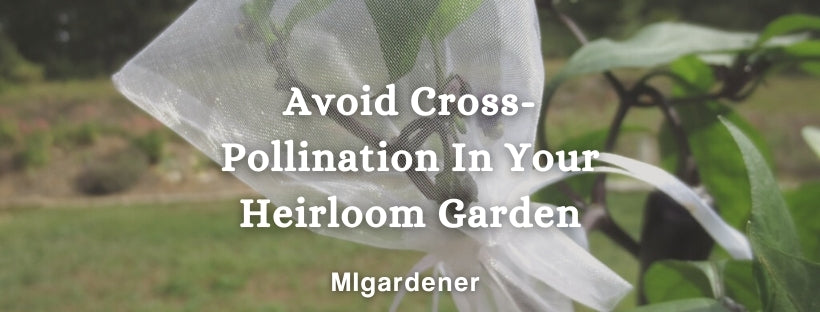
Avoid Cross-Pollination In Your Heirloom Garden
Pollination is a vital part of garden growth. Both edible and non-edible plants depend on pollination for survival. Some varieties don't require pollination between male and female flowers. For example, some hybrid varieties self-pollinate. Roses, lily's, and sunflowers all self-pollinate. Hybrids are great for growing in greenhouses, but for heirloom gardening, seed saving shouldn't include cross-pollination. Avoiding cross-pollination is simple for those who want the most beautiful heirloom varieties in their garden for years to come.
Here are some of MIgardener's go-to tips for avoiding cross-pollination in your heirloom garden.
Let's get started!
Garden Pollinators
We learned in previous blogs that delaying spring cleaning can increase the presence of pollinators in the garden. These pollinators work hard to create massive yields in the garden. Seeds can be saved from any plant, heirloom or not. However, if you want to ensure that you will grow the same variety year after year; monitoring cross-pollination is essential.

When you buy your seeds, it's important to remember which varieties are heirloom and which are not. Collecting seeds from heirloom plants that have not been cross-pollinated will give you a true plant every season. If there was any cross-pollination involved, different genetic characteristics will be present. No, this doesn't mean you grow an inedible mutant plant, but the genetics of each fruit won't be reliably the same. Hybrid seeds will still feed your family. However, heirloom varieties are known for having the best flavor profile on the market. Hybrid seeds aren't stable enough to produce identical yields the following year, sometimes resulting in stunted harvests.
Heirloom Insurance
There are a handful of ways to ensure pollination happens for every plant in your garden. Especially for seed-saving heirlooms, blossom bags are an affordable and simple way to protect flowers from cross-pollination. There is no need to blossom bag every fruit in your garden. A few blossoms covered will be the perfect amount for seed saving for the following growing season. For instance, if you are growing multiple pepper plants, blossom bag one or more fruits for the seeds that you will save. The rest of the fruit can be pollinated from the wind and pollinators around them and give you wonderful fruit. Use blossom bags for both artificially pollinated fruits and self-pollinated fruits. Place bags over the flower prior to blooming for self-pollinating plants. Place blossom bags over tomatoes, for example, as soon as the plant puts off a flowering cluster.

To pollinate inside blossom bags, shake the branch near the bag once the flowers have bloomed. You can also open the flowers yourself before placing the blossom bag over them. This avoids cross-pollination between different cultivars of similar plants. For example, if you plant multiple squash varieties near each other, they can all pollinate each other. When you save the seeds you will not be getting a squash true to the fruit the seeds were saved from. Cross-pollination does not affect the current season's fruit. It affects the seeds that will produce the next season's fruit.
Hand Pollination
Often garden plants such as squash pumpkins and melons can struggle with pollination. Deformed fruit can be one result of not properly pollinated varieties. Sometimes blossoms fall off and you may notice little to no fruit product. Hand pollinating these types of plants will be a gamechanger. You can hand pollinate by touching the flowers themselves to each other or by using an applicator like a paintbrush.

To hand pollinate with the flowers, take the male flower and touch it to the female flowers. Pull back petals and brush the anther containing the pollen on the stigma inside the female flower petals. Make sure to be thorough. You can use a male flower for up to 2-3 female flowers. if you choose the paintbrush route, make sure to use a clean paintbrush. Collect pollen from the male flower and transfer it to the female flower for full pollination. Male Flowers (as seen above) do not have baby fruit behind the flowers. You will just see a stem. Female flowers will eventually grow into a beautiful harvest, especially with these attentive pollinating techniques. For a great hand pollination video tutorial, click here.
Conclusion
These simple pollination tips will get any gardener, beginner or veteran, ahead in their garden. Cross-pollination can be entertaining when it happens by accident. These tips are perfect for beginner seed-savers. Nothing beats the beauty of an heirloom with perfect DNA passed on from generation to generation.
– Kaitlynn from MIgardener
Did you enjoy this post? MIgardener is passionate about sharing free gardening tips and information! If you are looking for inspiration in the garden, make sure to check out our Pinterest page. Check us out at MIgardener.com or on youtube, Instagram, and Facebook.

Leave a comment